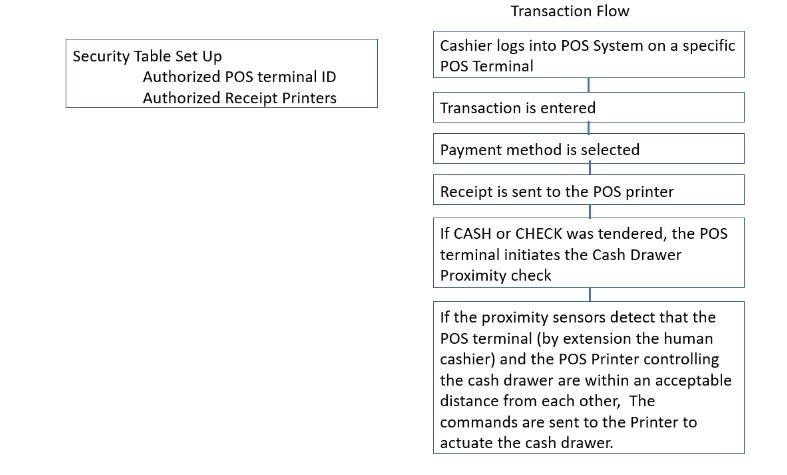Authors:
Sharon Freedman, Bill Gregory, Amir Najari, Mark Pickles
Abstract:
This solution provides a way to reduce the risk to the store of having an unattended open cash drawer. This solution keeps the cash drawer secure when the mobile POS terminal is not right next to the printer controlling the cash drawer
Background:
Mobile POS terminals are a new phenomenon within the retail industry. The industry standard is to have an RJ11 connector on the receipt printer for cash drawer use. The coming introduction of Toshiba’s new application suite will have a major set of mobile and network connected devices. The mobile terminal that sends commands to the printer controlling the cashdrawer could be physically far from the actual cash drawer, creating a security issue. This disclosure keeps the cash drawer secure when the mobile POS terminal is not right next to the printer controlling the cash drawer. It is common in the Retail and Hospitality industry for Point-of-Sale (POS) Software and Application writers to use a receipt printer to actuate a cash drawer. The printer can open the cash drawer through direct I/O commands or through driver calls. The emergence of mobile terminals for store associates (cashiers) has led to an increase in local network-attached receipt printers and wireless WiFi interfaced printers. The condition now exists where a cash drawer can be opened by a store associate that is not in the physical proximity of the cash drawer. The method disclosed herein is a way to reduce the risk to the store of having an unattended open cash drawer.
Description:
This solution would require both a hardware and software component. The hardware would need to have near-field sensing as most cellular phones and wireless terminal devices have. The important aspects are that the association of the terminal device and the target printer would be capable of recognizing the distance between the devices. For example, one would establish the printer communication over the store’s network (wired or wireless), and then a separate association between the terminal and the location data embedded in the printer. Only when the terminal and the printer are within a specified distance will the cash drawer port be enabled. This solution could also be expanded to any of the printer capabilities and/or connected device to the printer when the printer is used as a hub for other devices.


Enabling Technology:
- Near-Field Sensing
Supporting Art:
- https://patents.google.com/patent/US20160292737A1/en: This patent describes a mobile device that knows its location in relation to another system and sends commands to that system. This is similar, however, it is pretty broad. This is a more specific implementation.
- Other related prior art is functions in the printer to hold a print job until user is physically at the printer and could push a button, enter a password, etc.
- There are other location based prior are that are related. For example, having a key fob or phone that unlocks your car door when you get close to it.
TGCS Reference 3254









